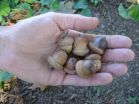(Press-News.org) Copenhagen, 16 March 2012: Stroke survivors who like art have a significantly higher quality of life than those who do not, according to new research. Patients who appreciated music, painting and theatre recovered better from their stroke than patients who did not.
The research was presented at the 12th Annual Spring Meeting on Cardiovascular Nursing, 16-17 March, in Copenhagen, Denmark.
Stroke is the third cause of death in the western world and the first cause of disability in adults. More and more older people are having strokes and undergoing recovery. "We know that every six seconds there is a person affected by stroke in the world," says lead author Dr Ercole Vellone, assistant professor in nursing science at the School of Nursing, University Tor Vergata, Rome, Italy. "Identifying strategies to improve stroke recovery and patients' quality of life represent a priority for the health care system and art exposure seems to be promising."
For the research (FPN 38), 192 stroke survivors (average age 70 years) were asked if they liked or did not like art (music, painting, theatre). Quality of life was compared for patients interested in art (105) and patients not interested in art (87).
Patients interested in art had better general health, found it easier to walk, and had more energy. They were also happier, less anxious or depressed, and felt calmer. They had better memory and were superior communicators (speaking with other people, understanding what people said, naming people and objects correctly).
Dr Vellone says: "Stroke survivors who saw art as an integrated part of their former lifestyle, by expressing appreciation towards music, painting and theatre, showed better recovery skills than those who did not."
"In our study the 'art' group of patients showed a comparable clinical picture to the 'no art' group," he adds. "This is important because it means that patients belonging to the 'art' group had a better quality of life independently from the gravity of stroke. The results suggest that art may make long term changes to the brain which help it recover when things go wrong."
Other researchers have shown that listening to our favourite music directly stimulates a feeling a pleasure by releasing dopamine in the brain. Dopamine is the starting point of the so-called gratification circuit that activates oxytocin (the hormone of love) and finally endorphins (the molecules of pleasurable emotions). "Dopamine improves quality of life each time it is released in the brain," says Dr Vellone. "Further research is needed to see if other art forms stimulate dopamine release."
He adds: "These results shed light on the importance of lifelong exposure to art for improving the recovery process after a stroke. Introducing art into nursing care after stroke could help improve stroke survivors' quality of life."
###
Authors: ESC Press Office
Tel: +33 (0) 4 92 94 86 27
Fax: +33 (0) 4 92 94 86 69
Email: press@escardio.org
Notes to editor
About the Annual Spring Meeting on Cardiovascular Nursing
The Annual Spring Meeting on Cardiovascular Nursing is the yearly meeting of the Council on Cardiovascular Nursing and Allied Professions (CCNAP) of the European Society of Cardiology (ESC). This year's meeting was organised jointly with the Professional Society for Cardiovascular and Thorax Surgery Nurses, based in Denmark.
About the Council on Cardiovascular Nursing and Allied Professions (CCNAP)
The CCNAP aims to promote excellence in Cardiovascular Nursing and Allied Professions through practice education and research. In addition to nurses, allied health professionals belonging to the CCNAP include physiotherapists, dieticians, psychologists, cath lab technicians, imaging and diagnostic technicians and therapists working in rehabilitation and prevention. The CCNAP is one of five Councils of the European Society of Cardiology.
About the European Society of Cardiology (ESC)
The European Society of Cardiology (ESC) represents 75,000 cardiology professionals across Europe and the Mediterranean. Its mission is to reduce the burden of cardiovascular disease in Europe.
References
The contribution of caregivers to self-care in heart failure: development of an instrument
END
Copenhagen, 16 March 2012: Depression increases the risk of death in patients who have a coronary stent implanted. After seven years of follow up, depressed patients were 1.5 times more likely to have died than non-depressed patients. The findings were independent of age, gender, clinical characteristics, anxiety and the distressed (Type D) personality.
The research was presented at the 12th Annual Spring Meeting on Cardiovascular Nursing, 16-17 March, in Copenhagen, Denmark.
Depression has been associated with poor outcomes in coronary artery disease but previous ...
Copenhagen, 16 March 2012: Poor dental hygiene behaviours in patients with congenital heart disease are increasing their risk of endocarditis. Teens with congenital heart disease floss, brush and visit the dentist less than their peers. But they have healthier behaviours when it comes to alcohol, cigarettes and illicit drugs. Adults with single ventricle physiology (a type of congenital heart disease) also have poorer dental hygiene practices than their peers despite having better health behaviours overall.
The findings were presented in two studies at the 12th Annual ...
Messier 9, pictured here, is a globular cluster, a roughly spherical swarm of stars that lies around 25 000 light-years from Earth, near the centre of the Milky Way, so close that the gravitational forces from the galactic centre pull it slightly out of shape.
Globular clusters are thought to harbour some of the oldest stars in our galaxy, born when the Universe was just a small fraction of its current age. As well as being far older than the Sun — around twice its age — the stars of Messier 9 also have a markedly different composition, and are enriched with far fewer ...
For the first time, the melting of glaciers in Greenland could now be measured with high accuracy from space. Just in time for the tenth anniversary of the twin satellites GRACE (Gravity Recovery and Climate Experiment) a sharp image has surface, which also renders the spatial distribution of the glacial melt more precisely. The Greenland ice shield had to cope with up to 240 gigatons of mass loss between 2002 and 2011. This corresponds to a sea level rise of about 0.7 mm per year. These statements were made possible by the high-precision measurements of the GRACE mission, ...
Widely used antibiotics may increase incidence and severity of allergic asthma in early life, according to a University of British Columbia study.
The study, published today in the journal EMBO reports, shows that certain antibiotics that affect intestinal bacteria also had a profound impact on allergic asthma.
"It has long been suspected that kids exposed to more antibiotics – like those in developed countries – are more prone to allergic asthma," says the study's author, UBC microbiologist Brett Finlay. "Our study is the first experimental proof that shows how."
Finlay's ...
One of the world's leading Internet security experts, Eugene Kaspersky, has described the World Cyber Security Technology Research Summit at Queen's University Belfast as key in preventing a Cyber World War.
Eugene Kaspersky, CEO and co-founder of the largest antivirus company in Europe, Kaspersky Lab, will be giving a keynote address at the second annual Cyber Security Technology Research Summit on Friday 16 March.
The cyber security guru is joining some of the world's leading cyber security experts and government policy makers from around the world for a two-day meeting ...
PITTSBURGH, March 16 – Researchers at the University of Pittsburgh School of Medicine have identified a cell-signaling pathway that plays a key role in increasing insulin secretion during pregnancy and, when blocked, leads to the development of gestational diabetes. Their findings are available online today in Diabetes, one of the journals of the American Diabetes Association.
During pregnancy, pancreatic beta cells should expand and produce more insulin to adapt to the needs of the growing baby, explained senior investigator Adolfo Garcia-Ocana, Ph.D., associate professor ...
CHICAGO – In a study that included a nationally representative sample of nearly 45,000 adults, participants who met more of seven recommended cardiovascular health behaviors or factors (such as not smoking, having normal cholesterol levels, eating a healthy diet), had a lower risk of death compared to participants who met fewer factors, although only a low percentage of adults met all seven factors, according to a study appearing in JAMA. The study is being published early online to coincide with its presentation at a specialty meeting of the American Heart Association.
"Cardiovascular ...
The northeastern U.S. should prepare for a surge in Lyme disease this spring. And we can blame fluctuations in acorns and mouse populations, not the mild winter. So reports Dr. Richard S. Ostfeld, a disease ecologist at the Cary Institute of Ecosystem Studies in Millbrook, NY.
What do acorns have to do with illness? Acorn crops vary from year-to-year, with boom-and-bust cycles influencing the winter survival and breeding success of white-footed mice. These small mammals pack a one-two punch: they are preferred hosts for black-legged ticks and they are very effective ...
Nanoparticles containing chitosan have been shown to have effective antimicrobial activity against Staphylococcus saprophyticus and Escherichia coli. The materials could be used as a protective wound-healing material to avoid opportunistic infection as well as working to facilitate wound healing.
Chitosan is a natural, non-toxic and biodegradable, polysaccharide readily obtained from chitin, the main component of the shells of shrimp, lobster and the beak of the octopus and squid. Its antimicrobial activity is well known and has been exploited in dentistry to prevent ...

